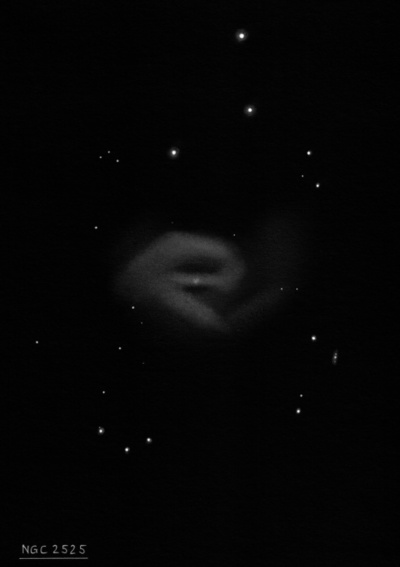
William Herschel discovered NGC 2525 = H III-877 = h486 on 23 Feb 1791 (sweep 995) and recorded "vF, iR, resolvable, about 2' in diameter, almost of equal light throughout." On 9 Mar 1828 (sweep 129), John Herschel wrote, "F; L; R; vgbM; 90"; among stars of the Milky Way."
The galaxy was sketched as a spiral by R.J. Mitchell on 30 Jan 1856, using Lord Rosse's 72". He described "vF, L, oval. Several F stars on edge, suspect others in the neb., also dark spaces. Nucl or * in centre? Spiral as in diagram. A year later he saw additional details: "light very unequal, suspect nucleus and a star close foll nucleus, also star in p edge? Again I though I saw a darkness across np centre [gap in spiral arms] and knots in np edge, but it is very uncertain."
300/350mm - 13.1" (1/11/86): fairly faint, large, slightly elongated E-W, diffuse, weak concentration. Located 3.8' NNE of mag 8.9 SAO 153813 and 6.2' S of mag 8.7 SAO 153816 on the Monoceros border.
600/800mm - 24" (2/8/18 and 2/13/18): at 200x and 375x; fairly bright, fairly large, oval 4:3 ~E-W, broad concentration, no distinct core at 200x but the halo appeared patchy or uneven (brighter and darker regions), strongly hinting at spiral structure. At 375x, a short low contrast central bar (elongated roughly 3:1 E-W) was visible with a slightly brighter nucleus.
13th magnitude SN 2018gv, discovered on Jan 15th, was easily visible at the southwest edge of the galaxy [50" west and 39" south of center]. A mag 14.5 star was easily seen close southwest of the supernova and a very faint and close pair is an additional 20" SW.
Notes by Steve Gottlieb